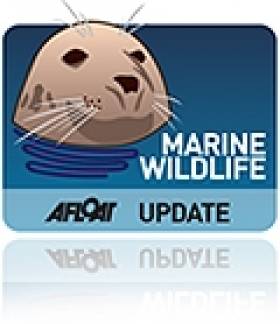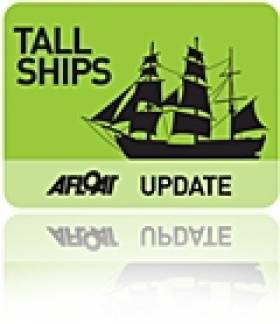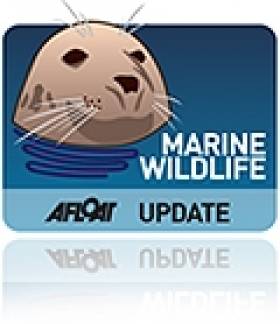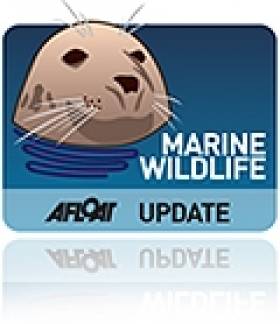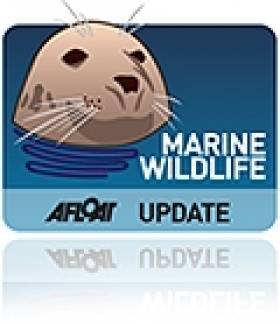Displaying items by tag: IWDG
Wexford Whale-Watching Trips As Seen On TV
#WexfordWhales – Further exciting scenes of cetaceans where witnessed by those on board Celtic Mist yesterday, following the first such sightings in 2013 as previously reported on Afloat.ie
Footage of the action was broadcast on this evening's RTE Six One news, from the decks of Ireland's newest marine research vessel, operated by the Irish Whale & Dolphin Group (IWDG).
This month, Celtic Mist will be making day trips in search of whales from Ballyhack on the Wexford side of the Waterford Estuary. In addition the 56ft ketch is to provide daily trips throughout February, when she will be based out of Kilmore Quay to where she heads for the waters off the Saltee Islands, weather permitting.
If you would like to join Celtic Mist for a day out, email: [email protected] or call 086 2358771 to make a booking and for further details visit www.rvcelticmist.ie
Celtic Mist, retains her original name from her days during ownership of the Haughey family, until she was donated to the IWDG back in 2011. She was refitted for her new role and she made her maiden voyage last September.
She was completed in 1974 by Custo in Brittany, France and designed by Dominique Presles. A 350HP diesel Caterpillar engine provides a maximum speed of 8.5 knots and a cruising speed of 6 knots. Facilities include a large galley, chart/navigation area and accommodation for eight berths.
First Whales of 2013 Sighted Off Wexford
#MarineWildlife - The whale watching season is well under way off the coast of Wexford, as the Irish Whale and Dolphin Group (IWDG) reported its first sightings of 2013 this week.
Just an hour into the maiden cetacean spotting voyage of the IWDG's new research vessel Celtic Mist at the weekend, members of the group were treated to the sight of fin whales and minke whales feeding south of Hook Head - not to mention some of the 'superpod' of dolphins seen last week in the Irish Sea.
And as World Irish reports, local wildlife ranger Tony Murray spotted the first humpback whale of the year in the same area.
Murray suggested that "a large herring haul going on in the southeast at the moment" is the main attraction for the ocean giants and their smaller, more plentiful companions.
The IWDG's Facebook page has a photo gallery containing some stunning snapshots of the day's excursion HERE.
Celtic Mist Trip Makes A Perfect Christmas Gift
#TallShips - If you're still stumped for the perfect Christmas gift for a maritime-minded loved one, how about a trip aboard Celtic Mist?
The Irish Whale and Dolphin Group's (IWDG) Celtic Mist Certificate entitles holders to a trip on board the cetacean research vessel, which was launched just months ago after extensive renovation work from its new home berth in the Shannon Estuary at Kilrush, Co Clare.
And if you're lucky, you might have a real whale of a time - like the video above showing some stunning underwater footage from the boat's maiden voyage in its new life.
As part of the fundraising campaign to refit Celtic Mist as a research vessel, the IWDG produced a very attractive A4 certificate acknowledging the support of the purchaser towards the refitting work and entitling them to a voyage on board the vessel.
As previously reported on Afloat.ie, Celtic Mist - the yacht formerly sailed by late Taoiseach Charles Haughey - was gifted by the Haughey family to the IWDG to assist in its marine wildlife conservation work.
A €60,000 refit of the sailing ketch - and former Tall Ships Races competitor - was completed in August this year, which saw extensive work on the interior of the vessel to transform crew accommodation and make space for scientific instruments necessary for the IWDG's research mission.
Humpback, Fin Whales Moving East Along Cork Coast Says IWDG
#MarineWildlife - The Irish Whale and Dolphin Group (IWDG) reports of another "frenzy of activity" while on a whale research cruise off West Cork this week.
The 'members only' trip on Wednesday 5 December took in the hotspot west of Reen Pier in Union Hall "where humpback and fin whales have enthralled hundreds of whale watchers and wildlife enthusiasts alike in recent weeks," according to IWDG sightings co-ordinator Pádraig Whooley.
When it soon became clear that most of the whales had left the area, the team headed east to return an ill member to shore.
"This turn of events proved almost karmic," says Whooley, "as not long after dropping our colleague back to Reen Pier, we started getting text messages from IWDG observers Tim Feen and Chris O'Sullivan of both humpback and fin whales well to the east on the Clonakilty Bay side of Galley Head."
Racing against the fading afternoon light, the boat made it to the scene to witness the blows first of fin whales, then humpbacks - at least five of the latter and seven of the former - and confirming them as the giants previously seen between the Kedge and Stags.
The team collected biopsy samples from most of the relaxed pod, including one that is suspected to be a female humpback with a calf.
"Since then, the weather has been very poor," says Whooley, "but there are still sufficient reports coming into IWDG to suggest to us that the large whale activity is slowly pushing east."
The IWDG is also collaborating with the BBC's WinterWatch programme next week, which is hoping to follow up on last year's AutumnWatch special on fin whales from East Cork and Waterford by filming humpback whales in West Cork.
Members of the public or whale-watchers are encouraged to report any sightings they might witness over the weekend to the IWDG by using the 'Report a sighting' link on the home page at iwdg.ie.
Concern Over Impact of Seismic Survey on Dublin Bay Porpoises
#PORPOISES - The Irish Whale and Dolphin Group (IWDG) has expressed concern over the potential impact of a 2D seismic survey on harbour porpoises in Dublin Bay.
As recently reported on Afloat.ie, Providence Resources has been granted a foreshore license for the Dalkey Island Prospect in the Kish Bank Basin to allow for a well site survey, and exploration well and a seismic survey.
But the IWDG has written to Minister of State Jan O'Sullivan suggesting that he Environmental Risk Assessment (ERA) conducted on the area is deficient.
The group argues that the ERA has not assessed the footprint of the seismic survey, saying the mitigation proposed is inadequate and that the disturbance and impact to cetaceans – especially harbour porpoise – is "potentially significant and in contravention of national legislation and EU Directives".
Moreover, the IWDG claims that an Environmental Impact Assessment (EIA) of the effect of a seismic survey on harbour porpoise "doesn’t seem to have been carried out".
The harbour porpoise, which is an Annex II species, is entitled to strict protection. The species has been recorded at very high densities in Dublin Bay during surveys carried out by the IWDG in 2008 on behalf of the National Parks and Wildlife Service (NPWS).
The group says that impact monitoring is needed to gather data on the effects of seismic surveys on harbour porpoises, and recommends it as an additional condition on the license.
"Compliance with the NPWS guidelines does not constitute monitoring and as porpoises are elusive and spend 95% of their time underwater and are difficult to see in a sea state greater than Force 1, the guidelines do not serve to protect them once the works are on-going.
"In addition there are specific data required on their site usage prior to the works and a monitoring plan to assess how they recover after the works."
Moreover, the IWDG claims that in this instance the NPWS "are negligent, as they are not providing strict protection to an Annex II species."
Earlier this year Environment Minister Phil Hogan rejected a call from Tánaiste Eamon Gilmore and others for a public enquiry into the Dalkey Island foreshore licence.
Baltimore Whale Remains Dumped At Sea
#MARINE WILDLIFE - The carcass of the fin whale that died after being trapped in Baltimore Harbour two months ago has been towed out to sea after its presence in a conservation area attracted complaints.
According to the Irish Examiner, disappointment has been expressed by a local group in Baltimore who hoped to salvage the skeleton of the 65ft female fin whale, the remains of which have now been towed out beyond Fastnet Rock for disposal.
Last week Afloat.ie reported on claims from local resident Tom McCarthy, among others from the Schull area, that the whale carcass was creating a "rancid oil slick" with a "horrendous smell" in Roaringwater Bay, a Special Area of Conservation for marine wildlife that houses a grey seal breeding ground.
However, the Irish Whale and Dolphin Group (IWDG) - which was working with Baltimore residents on their plan to retrieve the bones with a view to displaying the skeleton in the town - criticised the decision by Cork County Council to dump the remains.
IWDG sightings co-ordinator Pádraig Whooley pointed the finger at "vested interests" exaggerating claims about health hazards, arguing that "towing it out to sea raises the very real possibility that [it] could simply wash up on the coast again."
The Irish Examiner has more on the story HERE.
Irish Whale and Dolphin Group Appoints Three New Officers
#MARINE WILDLIFE - The board of directors of the Irish Whale and Dolphin Group (IWDG) has announced the appointment of three new officers to cover the roles of conservation, Northern Ireland and the Irish language.
The new IWDG conservation officer is Dr Joanne O’Brien, a postdoctoral researcher and lecturer at the Galway-Mayo Institute of Technology (GMIT).
Dr O'Brien lectures on the Applied Freshwater and Marine Biology degree. She has been working on cetaceans (whales, dolphins and porpoise) since 2004 and completed a PhD on small cetaceans off the west coast of Ireland in 2009.
She is particularly interested in acoustic monitoring and is currently principal investigator on an EPA-funded project exploring ocean noise and its impact on marine wildlife.
Padraic de Bhaldraithe is the new IWDG Irish language officer, following stints in postgraduate research in biological oceanography in Galway and in the Centre Nationale de l’Exploration des Océans in Brest, France.
After teaching in a second-level school for 10 years, he joined the inspectorate of the Department of Education and subsequently seconded to the State Examinations Commission where he was the chief examiner for Biology.
De Bhaldraithe has been a member of the IWDG for a number of years. He is also a keen sailor – and a founding member of the Galway Hooker Association – and currently works as a freelance translator.
The third appointee is Zoë Stevenson, the new Northern Ireland officer. She recently graduated from Swansea University and her passion for whales and dolphins have taken her all over the world. She’s seen humpback whales in Costa Rica, Hector’s dolphins in New Zealand and fin whales in Italy, just to name a few.
The IWDG will soon be appointing three more officers to the areas of welfare, education and science.
Blue Whales Spotted Off Kerry Coast in Ireland's Third Ever Sighting
#MARINE WILDLIFE - Members of the Irish Whale and Dolphin Group (IWDG) encountered the world's largest animals off the southwest coast of Ireland last Thursday.
Two blue whales were witnessed by the team on board the Celtic Mist near the edge of the continental shelf on the Porcupine Blight, west of Dursey Island in Co Kerry.
The marine giants - last recorded in Irish waters back in 2008 - reportedly surfaced within 500 metres of the boat.
Mission co-ordinator Patrick Lyne told The Irish Times that there may even have been three whales in the pod, as three blows of seawater were witnessed in a short space of time.
He also noted that the sighting was very significant as there are estimated to be fewer than 4,000 blue whales in the entire northern hemisphere - their numbers reduced drastically by whaling over the past hundred years.
At an average of 30 metres in lengh and an incredible 180 metric tins in weight, the blue whale is the largest animal to have ever lived on earth.
The Celtic Mist was on its maiden voyage as a research vessel for the IWDG, following its gifting to the group for marine wildlife conservation work by the Haughey family last year, and subsequent major refitting works.
The vessel set sail on Monday 3 Septmeber on a marine mammal observation and passive acoustic monitoring week, carrying a towed hydrophone array for acoustic detections below the surface.
During the weeklong mission the team on board enountered 11 different cetacean species including harbour porpoises, common dolphins, minke whales and a humpback whale.
Link to Blue Whales Spotted During an Air Corps Maritime Patrol
Whale Watch Ireland Produces Good Sightings Despite Poor Weather
#MARINE WILDLIFE - Loop Head in Clare was certainly the place to be for the annual Whale Watch Ireland on Sunday 19 August, with dolphins and two species of whale spotted despite the poor weather.
According to the Irish Whale and Dolphin Group (IWDG), which organised the national event in conjunction with National Heritage Week to promote consevation of Ireland's marine wildlife, some 80 whale watchers and curious beginners spotted 11 bottlenose dolphins, a minke whale and a large baleen whale species - the only whales seen on the day among the 16 organised coastal watches.
Overall sightings were good, even with the unfavourable conditions experienced at half the viewing sites, and which saw the event at Baginbun Head on the Hook Peninsula in Co Wexford sadly cancelled.
In total, cetateans were seen at 10 of the 16 sites, which is up on the 54% viewing rate recorded at last year's national whale watch.
The biggest attended sites this year were Killiney Bay in Dublin, where three harbour porpoises were seen by 100 viewers; Galley Head in Cork, where six porpoises were witnessed in adverse weather that still brought out 120 eager cetation spotters.
Dolphins and porpoise together entertained the modest crowds at Howth head in north Dublin, St John's Point in Donegal and Bloody Bridge in Co Down, while the biggest count of bottlenose dolphins apart from Loop Head was the 10 recorded at Portmuck in Antrim.
Samples Taken from Baltimore Fin Whale Carcass
#MARINE WILDLIFE - The Irish Examiner reports that samples from the fin whale that stranded and died in Baltimore Harbour last week have been sent to Dublin for analysis.
Samples of skin and blubber will be tested by marine science experts at the Irish Cetacean Tissue Bank in the Natural History Museum as well as at the Marine Institute, while a student studying for a PhD on the feeding ecology of fin whales will also examine the remains.
As reported yesterday on Afloat.ie, the whale carcass has been towed out of the inner harbour as preparations are made to sink it to the seabed, where marine life such as fish and crabs will quickly strip it down to a skeleton that locals hope to put on display in the West Cork town.
A post-mortem will not be carried out by the Irish Whale and Dolphin Group (IWDG) due to lack of funding for the specialised procedure. A previous necropsy of a fin whale stranded at Courtmacsherry was funded by the US-based magazine National Geographic.



























